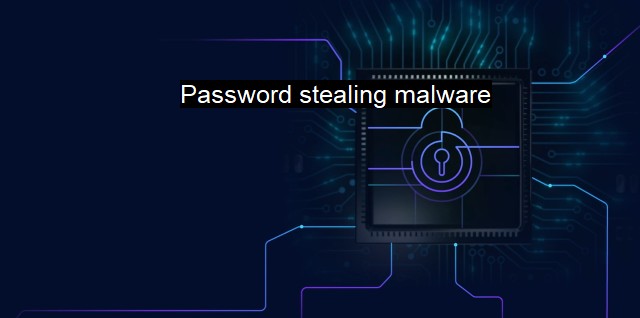What is Password stealing malware?
Password Stealing Malware: A Threat to Computer Security and Confidential Information
Password stealing malware is a type of malicious program designed specifically to steal and exploit sensitive information, especially passwords, from users’ computers or online activities, such as web browsing. Understanding its full scope involves delving into the core of cybersecurity and antivirus measures.At a basic level, password stealing malware or password stealers, as they are commonly known, seize control of a computer unnoticed, often hidden within harmless-looking software downloads or email attachments. They can also infiltrate a user's system through malicious sites or via vulnerabilities in the existing system software. By operating under the radar, this kind of malware elicits personal information, financial details, and crucially the passwords, enabling it to engage in a range of malicious activities, from identity theft to unauthorized bank transactions.
Within the realm of cybersecurity practices, the methods employed by this form of malware tend to be somewhat sophisticated. The most common password stealing malwares include keyloggers, phishing malware, and ransomware, among others. Keyloggers record every keystroke made on a computer, divulging not just passwords, but everything the user types. The manner in which keyloggers operate offers the potential for substantial violations of privacy, as no form of direct interaction is required.
Phishing malware lays traps, often in the guise of legitimate websites or emails, designed to trick the user into voluntarily disclosing their password. This may take many forms, such as fake banking websites, fraudulent credit card inquiries, or non-existent technical support that ostensibly requires user login to resolve 'issues'.
Ransomware, on the other hand, typically enters a system via seemingly innocent emails or attachments and runs a script that encrypts vital files on the system, essentially locking the user out. Demands, often stratospheric, are then made to unlock the data - typically in the form of cryptocurrency, which ensures anonymity of the miscreants.
In this context, effective antivirus measures are vital as a frontline defense against password stealing malware. A well-maintained antivirus program offers real-time protection against such threats. It safeguards the system against known threats and monitors system behavior to identify uncharacteristic activity that could indicate a malware infection.
Cybersecurity practices, such as using complex and distinct passwords for different services, can significantly reduce the risk of password theft. Other security safeguards like two-step verification, maintaining updated software, avoiding suspicious email attachments and links, can help users ensure a more robust line of defense against cyber threats.
One of the universal truths about malware, including password stealers, is that they are constantly evolving in a relentless attempt to stay one step ahead of the defences created to repel them. This ongoing struggle between nefarious actors in the realm of cyber-crime and entities striving to maintain cybersecurity can, at times, resemble an arms race. As existing threats are addressed, new ones emerge, often with unpredictably increased levels of sophistication, engendering seemingly ceaseless cyclical threats.
Password stealing malware poses one of the significant threats in today's digital age. Its characteristics, approach to data theft, and impact underline the importance of not only having potent protective measures in place but also fostering a sustained commitment to cybersecurity education. Thus, users must be perpetually vigilant, recognizing that our shared reliance on digital services doesn't just offer enormous conveniences and efficiencies, but also raises somber and significant security risks.

Password stealing malware FAQs
What is password stealing malware?
Password stealing malware is a type of malicious software that is designed to steal sensitive information such as usernames and passwords from infected devices. This type of malware can compromise your personal and financial information and put you at risk of identity theft.How does password stealing malware work?
Password stealing malware works by infecting your device through various methods such as phishing emails, downloading infected attachments, or visiting compromised websites. Once the malware takes hold of your system, it can capture your keystrokes or monitor your browsing sessions to find and steal login credentials.What can I do to protect myself from password stealing malware?
To protect yourself from password stealing malware, you should always keep your antivirus software up to date, avoid clicking on suspicious links or attachments, and use strong and unique passwords for all of your accounts. It's also a good idea to enable two-factor authentication whenever possible.What should I do if I suspect my device has been infected with password stealing malware?
If you suspect that your device has been infected with password stealing malware, you should immediately run a full scan using your antivirus software. If the malware is detected, follow the instructions provided by your antivirus program to remove it. Additionally, you should change the passwords for any accounts that may have been compromised and monitor your financial accounts for any suspicious activity.| | A | | | B | | | C | | | D | | | E | | | F | | | G | | | H | | | I | | | J | | | K | | | L | | | M | |
| | N | | | O | | | P | | | Q | | | R | | | S | | | T | | | U | | | V | | | W | | | X | | | Y | | | Z | |
| | 1 | | | 2 | | | 3 | | | 4 | | | 7 | | | 8 | | |||||||